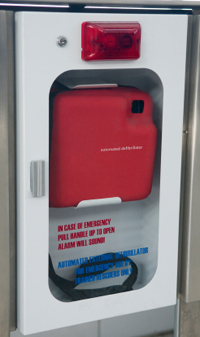Cardiac arrest & ventricular fibrillation
 Ventricular fibrillation is form of cardiac arrest where the muscles of the heart contract in an uncoordinated way, and fail to pump blood around the body. It often occurs as a consequence of a heart attack, and is the leading cause of death in the industrialised world.
Ventricular fibrillation is form of cardiac arrest where the muscles of the heart contract in an uncoordinated way, and fail to pump blood around the body. It often occurs as a consequence of a heart attack, and is the leading cause of death in the industrialised world.
Ventricular fibrillation was first described in 1842 by John Erichsen, studying dogs whose coronary artery had been ligated. Interest in the phenomenon increased in 1849 when Carl Ludwig and M Hoffa demonstrated that it could be induced by applying an electric current to the heart of a dog. The British scientist John. A. MacWilliam was one of several scientists to carry out animal studies of his own and in 1889 published a paperANCHOR which described many important features of ventricular fibrillation, including the surprising observation that the activity in the muscle was independent of the nervous system.
MacWilliam was also the first scientist to recognize that ventricular fibrillation might be a leading cause of death in man, and one that it was possible to treat. Unfortunately it was several decades before the medical community realised that, as Claude Beck later put it, patients were dying despite the fact that they had a "heart too good to die". The importance of ventricular fibrillation in man became clear in the 1920's following the development of the electrocardiogram and its subsequent use to examine cardiac patients. The development of the electrocardiogram itself owed much to animal studies carried out in the late 19th and early 20th century by scientists such as William Einthoven.
In the meantime other scientists were developing methods to treat ventricular fibrillation. In 1899 Jean Louis Prevost and Frederic Batelli in Geneva demonstrated that electrical currents could be used to restore normal rhythm to the canine heart, thereby inventing the first electrical defibrillatorANCHOR. At the time of its discovery this technique was far from ready for clinical use, but the research inspired other scientists to study the effects of electric current on ventricular fibrillation. Among those scientists was Carl J. Wiggers of the Western Reserve University in Ohio, who performed many careful experiments in dogs.
Dr Wiggers identified the different stages in ventricular fibrillation and greatly improved defibrillation techniques. In 1947 the surgeon Claude S. Beck, who practiced the University Hospital next door and was very familiar with Carl Wiggers work, carried out the first successful defibrillation using a defibrillation machine that Carl Wiggers had advised him to install in the operating theatreANCHOR.
The early defibrillators were successful, but they had a great disadvantage: the paddles had to be applied directly to the heart, which of course required major surgery. The first successful "closed chest" defibrillation was performed by Paul Maurice Zoll in 1956ANCHOR. Paul Zoll's achievement was based on research using dogs undertaken a couple of years earlier by William Kouwenhoven and William Milnor, and his own early animal and clinical research on the external pacemaker. He later described the first time he observed stimulation of the canine ventricle by application of electric current to the chest “I think I recognized at that time that a new field of electric cardiac stimulation had begun. I think I foresaw almost all of the implications of what has followed in the next 25 years.”ANCHOR.
The next major advance was made by Bernard Lown, who carried out a series of studies involving hundreds of dogs to try and identify a form of electric shock that was less damaging to the heart than the alternating current used in the early defibrillators, finally identifying a direct current wave form, dubbed the "Lown waveform, that was effective and far saferANCHOR. The Lown waveform became the standard for defibrillation as the technique rapidly gained popularity in coronary care units during the 1960's and 1970's, until it was superseded by the biphasic truncated waveform in the1990's.
The biphasic truncated waveform was first developed by the Russian scientist Naum L Gurvich in the 1960'sANCHOR after years of research in animals, though it was not until the 1980's that research in the west indicated its superiority to the Lown waveformANCHOR.Naum Gurvich and his colleagues had been working on defibrillation since the 1930's independently of western scientists and developed their own version of the defibrillator that was used widely in the Soviet Union. As with many technologies, communications on defibrillation fell victim to cold war tension and language barriers. The major advantage of the biphasic waveform over the Lown waveform was that it required less energy, which made it even safer for the patient than the Lown waveform due to a reduced risk of burns and muscle damage. The reduced power requirement also enabled the manufacture of lighter, more portable machines with obvious advantages for the automated external defibrillators that since the end of the 1970's have increasingly being used by laypersons to save lives.
The major advantage of the biphasic waveform over the Lown waveform was that it required less energy, which made it even safer for the patient than the Lown waveform due to a reduced risk of burns and muscle damage. The reduced power requirement also enabled the manufacture of lighter, more portable machines with obvious advantages for the automated external defibrillators that since the end of the 1970's have increasingly being used by laypersons to save lives.
Defibrillators have come a long way in the last half-century, and now save lives on the streets and even in the air as well as in hospitals. Animal research made an enormous contribution to the invention and subsequent constant improvement of the defibrillator, and several of these key discoveries were made even before the importance of ventricular fibrillation in cardiac patients was fully appreciated. The 1990s the first publicly available defibrillators in the UK were provided by the British Heart Foundation. Their success in preventing deaths in cases of sudden cardiac arrest has since led to the installation of defibrillation machines in airports, railway stations and sports centres.
References
- MacWilliam JA. (1887) "Fibrillar contraction of the heart." J Physiol 8, pages 296-310
- J.L. Prevost and F. Batelli, (1899) "Sur quelques effects des décharges électriques sur le cœur des Mammifères." C R Seances Acad. Sci 129, pages 1267–1268.
- C.F. Beck, W.H. Pritchard and H.S. Feil (1947) "Ventricular fibrillation of long duration abolished by electric shock." JAMA 136, pp. 985–986.
- P.M. Zoll, et al (1956) "Termination of ventricular fibrillation in man by externally applied electric countershock." N Engl J Med 254, pages 727–73.
- P.M. Zoll and A.J. Linenthal (1963) "Program for Stokes-Adams disease and cardiac arrest" Circulation 27, pages 1-4.
- B. Lown, R. Amarasingham and J. Neuman (1962) "New method for terminating cardiac arrhythmias: use of synchronized capacitor discharge." JAMA 182, pages 548–555.
- N.L. Gurvich and V.A. Makarychev, (1967) Defibrillation of heart by the biphasic waveform, Cardiology 7, pages 109–112 [in Russian].
- Flaker GC, (1989) "Superiority of biphasic shocks in the defibrillation of dogs by epicardial patches and catheter electrodes." Am Heart J. 118(2), pages 288-91.
Last edited: 18 September 2014 10:19
